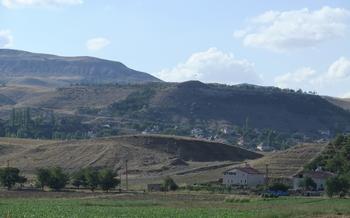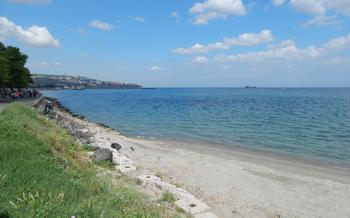
Koyunbaba Bridge an Ottoman era bridge in Osmancık
- Koyunbaba Bridge: A Timeless Masterpiece
- A Journey Through Time: Historical Significance
- Architectural Marvel: Unveiling the Design
- Crossing the Koyunbaba Bridge: A Unique Experience
- Historical Context: The Ottoman Empire's Legacy
- The Kızılırmak River: A Vital Waterway
- Osmancık: A Hidden Gem of Çorum
- Exploring Osmancık: Beyond the Koyunbaba Bridge
- Getting to Koyunbaba Bridge: A Practical Guide
- Tips for Visiting Koyunbaba Bridge
- The Legend of Koyunbaba: A Folk Tale
- Koyunbaba Bridge in Literature and Art
- Environmental Conservation: Protecting the Kızılırmak River
- Local Cuisine: A Taste of Osmancık
- Insider Tip: Unveiling Hidden Gems
Koyunbaba Bridge: A Timeless Masterpiece
Amidst the scenic landscapes of Çorum, Turkey, stands a remarkable testament to Ottoman-era engineering – the Koyunbaba Bridge in Osmancık. This architectural marvel, dating back to the 15th century, has gracefully withstood the relentless passage of time, serving as a poignant reminder of the region's rich history and engineering prowess. Its unique single-arch design, constructed using local stone and mortar, sets it apart from other Ottoman bridges, showcasing the exceptional craftsmanship and ingenuity of its builders. Spanning elegantly over the Kızılırmak River, the Koyunbaba Bridge remains a symbol of resilience, enduring as a vital connection between past and present.
A Journey Through Time: Historical Significance
The Koyunbaba Bridge, a remarkable Ottoman-era bridge spanning the Kızılırmak River in Osmancık, Çorum, Turkey, stands as a testament to the enduring legacy of the Ottoman Empire. Its origins can be traced back to the 15th century, when it was commissioned by the renowned Ottoman Sultan Bayezid II, a visionary ruler who oversaw the construction of numerous bridges and other infrastructure projects throughout his vast empire. The bridge's strategic location along important trade routes facilitated the movement of goods and people, contributing to the economic and cultural development of the region. Over the centuries, the Koyunbaba Bridge has withstood the test of time, undergoing meticulous restoration efforts to preserve its historical significance and architectural grandeur for generations to come.
Architectural Marvel: Unveiling the Design
The Koyunbaba Bridge stands as a testament to the exceptional engineering skills of the Ottoman Empire. Its single-arch structure, a unique feature among Ottoman bridges, showcases the innovative approach of its builders. Constructed using locally sourced stone and mortar, the bridge exhibits remarkable resilience and longevity. Spanning gracefully over the Kızılırmak River, its impressive dimensions speak to the ambitious vision of its architects. The bridge's symmetry and precision reflect the meticulous attention to detail that characterized Ottoman engineering, leaving a lasting legacy of architectural prowess.
Crossing the Koyunbaba Bridge: A Unique Experience
The Koyunbaba Bridge offers a truly unique and unforgettable experience for visitors. As a pedestrian-friendly crossing, it allows you to leisurely stroll across the bridge, taking in the stunning panoramic views of the Kızılırmak River and the surrounding landscape.
The bridge exudes an aura of serenity and tranquility, providing a peaceful retreat from the hustle and bustle of the city. As you cross the bridge, you can't help but feel a sense of connection to the past, as if you are walking through a living piece of history.
More than just a historical monument, the Koyunbaba Bridge is also a symbol of resilience and continuity, connecting the past with the present and bridging the gap between cultures. It stands as a testament to the enduring legacy of the Ottoman Empire and serves as a reminder of the importance of preserving our cultural heritage.
Historical Context: The Ottoman Empire's Legacy
The Koyunbaba Bridge stands as a testament to the enduring legacy of the Ottoman Empire, a vast and powerful empire that ruled over much of the Middle East, North Africa, and Southeastern Europe for over six centuries. The bridge's construction during the reign of Sultan Bayezid II reflects the empire's commitment to infrastructure development and its prowess in engineering and architecture.
The Ottomans were renowned for their extensive road network, which facilitated trade, travel, and the movement of armies. The Koyunbaba Bridge played a crucial role in this network, connecting trade routes and enabling the transportation of goods and people across the Kızılırmak River.
Beyond its practical significance, the bridge also served as a symbol of Ottoman power and prestige. Its impressive design and construction showcased the empire's engineering capabilities and artistic achievements. The Ottomans were known for their patronage of architecture, and the Koyunbaba Bridge stands as a testament to their commitment to building monumental structures that would endure for centuries.
The bridge's design influenced future bridge construction in the Ottoman Empire. Its unique single-arch structure became a model for other bridges, demonstrating the Ottomans' willingness to experiment with innovative architectural forms.
The Koyunbaba Bridge is not just a historical relic; it is a living testament to the Ottoman Empire's legacy. It continues to serve as a vital link between communities, a symbol of resilience, and a reminder of the empire's enduring impact on the region.
The Kızılırmak River: A Vital Waterway
Flowing proudly through the heart of Çorum, Turkey, the Kızılırmak River, meaning "Red River" in Turkish, is a vital waterway with a rich history and diverse significance. As one of Turkey's longest rivers, stretching over 1,350 kilometers, it has played a pivotal role in the region's geography, history, and culture.
In ancient times, the Kızılırmak served as a major trade and transportation route, connecting different regions and facilitating the exchange of goods and ideas. Its proximity to ancient settlements and cities made it a strategic waterway, influencing the rise and fall of civilizations.
Beyond its historical importance, the Kızılırmak River boasts stunning natural beauty. Its crystal-clear waters meander through picturesque landscapes, creating breathtaking vistas that captivate visitors. The river's banks are adorned with lush vegetation, providing a habitat for diverse flora and fauna.
The river's natural beauty has also made it a popular destination for recreational activities. Anglers can enjoy fishing in its teeming waters, while boaters can embark on leisurely excursions, soaking in the tranquil ambiance. Birdwatching enthusiasts are drawn to the river's diverse avifauna, which includes a variety of migratory birds that make the river their temporary home.
The Kızılırmak River is a vital part of the Çorum region, providing water for irrigation, drinking, and industrial use. It sustains the livelihoods of local communities and contributes to the region's economic development. Its cultural and ecological significance makes it a treasured natural resource, cherished by both locals and visitors alike.
Osmancık: A Hidden Gem of Çorum
Beyond the Koyunbaba Bridge, Osmancık unfolds as a hidden gem of Çorum, inviting travelers to delve into its rich history, vibrant culture, and natural wonders. This charming town exudes a regional charm, steeped in time-honored traditions and warm hospitality.
Osmancık boasts a wealth of cultural attractions, including museums, historical sites, and a vibrant local crafts scene. Visitors can immerse themselves in the town's past at the Osmancık Museum, housing artifacts and exhibits that narrate the region's captivating history. The Ulu Mosque, with its striking architecture and intricate tilework, stands as a testament to Osmancık's religious heritage.
For those seeking culinary delights, Osmancık offers a tantalizing array of traditional Turkish cuisine and regional specialties. Savor the flavors of keşkek, a hearty dish of wheat, meat, and spices, or indulge in mantı, delicate dumplings served with yogurt and garlic sauce. The local markets brim with fresh produce, inviting visitors to sample seasonal fruits and vegetables, embodying the essence of Anatolian cuisine.
Osmancık's welcoming locals and vibrant community create a warm and inviting atmosphere, ensuring that every visitor feels at home. Engage with the friendly residents, learn about their customs, and experience the true essence of Turkish hospitality.
Exploring Osmancık: Beyond the Koyunbaba Bridge
While the Koyunbaba Bridge stands as a testament to Osmancık's rich history, the town offers a wealth of other attractions that showcase its diverse cultural heritage and natural beauty.
Historical Sites:
Osmancık Castle, a magnificent fortress dating back to the Byzantine era, stands as a silent witness to the town's storied past. Within its imposing walls lie remnants of ancient civilizations, waiting to be discovered. The Ulu Mosque, with its intricate architecture and serene atmosphere, invites visitors to immerse themselves in the town's spiritual essence. Ottoman-era houses, with their charming facades and traditional designs, line the streets, adding a touch of nostalgia to the town's ambiance.
Natural Wonders:
Osmancık's natural wonders are equally captivating. The Ilıca Waterfall, with its cascading waters and vibrant surroundings, offers a refreshing respite from the hustle and bustle of city life. The Göksu Cave, with its subterranean chambers and glistening stalactites, invites visitors to explore the depths of the earth.
Local Markets:
For those seeking a taste of local life, the bustling markets of Osmancık offer a vibrant array of goods and produce. From fresh fruits and vegetables to traditional Turkish handicrafts, these markets are a treasure trove of local delights. Visitors can bargain with vendors, savor the aromas of freshly baked bread, and discover unique souvenirs to cherish their time in Osmancık.
Festivals and Events:
Osmancık comes alive during its many festivals and events, showcasing the town's vibrant culture and traditions. The annual Koyunbaba Festival, held in honor of the legendary figure associated with the bridge, is a highlight of the town's calendar. Visitors can immerse themselves in local music, dance, and traditional Turkish cuisine as the town celebrates its heritage.
Getting to Koyunbaba Bridge: A Practical Guide
Reaching the Koyunbaba Bridge is a breeze, with a variety of transportation options available to suit your needs and preferences. Buses and taxis are readily accessible, providing a convenient and affordable way to travel. If you prefer the freedom of self-exploration, rental cars are also available, allowing you to set your own pace and explore the surrounding area at your leisure.
The roads leading to the bridge are well-maintained and easily navigable, ensuring a comfortable journey. Ample parking spaces are available near the bridge, providing a safe and secure place to leave your vehicle while you marvel at this architectural masterpiece.
For those with limited mobility, the Koyunbaba Bridge is wheelchair-accessible, featuring designated paths and ramps to facilitate easy access. This thoughtful provision ensures that everyone can enjoy the beauty and historical significance of this iconic landmark.
Tips for Visiting Koyunbaba Bridge
To fully appreciate the timeless beauty of the Koyunbaba Bridge, consider these helpful tips to enhance your visit:
- Ideal Time to Visit: For the most pleasant weather conditions, plan your visit during the spring or autumn seasons, when the temperatures are mild and comfortable.
- Capture the Perfect Moment: If you're a photography enthusiast, aim to visit the bridge during sunrise or sunset to capture the magical play of light and shadow on its ancient stone structure.
- Safety First: Be mindful of slippery surfaces and uneven steps, especially during wet weather. Wear comfortable shoes with good traction to ensure a safe and enjoyable walk across the bridge.
- Local Expertise: Consider hiring a local guide to gain insights into the rich history and legends surrounding the Koyunbaba Bridge. Their knowledge will help you appreciate the significance of this architectural masterpiece.
The Legend of Koyunbaba: A Folk Tale
Beyond its historical and architectural significance, the Koyunbaba Bridge is entwined with a captivating local legend, adding a mystical charm to its allure. The tale of Koyunbaba, passed down through generations, has become an integral part of the bridge's identity.
According to local folklore, Koyunbaba was a shepherd who lived in the vicinity of the bridge. He was deeply devoted to his flock and spent his days tending to their needs. One fateful day, as Koyunbaba was crossing the bridge with his sheep, he encountered a group of ruthless bandits.
The bandits, driven by greed, attempted to steal Koyunbaba's precious flock. However, Koyunbaba refused to surrender his livelihood without a fight. He valiantly defended his sheep, but the bandits overpowered him.
In a desperate moment, Koyunbaba turned to divine intervention. He prayed fervently to Allah, seeking protection and justice. Miraculously, as his prayers reached the heavens, a blinding light descended upon the bridge.
The bandits were struck with awe and fear. They dropped their weapons and fled in terror. Koyunbaba emerged from the encounter unscathed, his flock safe and sound.
From that day forward, Koyunbaba became revered as a saint and protector by the local people. His selfless act of courage and unwavering faith earned him the title of "Koyunbaba," meaning "Shepherd Father."
A shrine and mausoleum were erected near the bridge in his honor. Pilgrims from far and wide come to pay homage to Koyunbaba, seeking blessings, protection, and guidance. The legend of Koyunbaba continues to be a source of inspiration and faith for the people of Osmancık and beyond.
Koyunbaba Bridge in Literature and Art
The Koyunbaba Bridge, with its timeless beauty and rich history, has served as a muse for numerous literary and artistic creations. Local authors have woven tales of love, loss, and legend around the bridge, capturing its essence in prose and poetry. These literary works not only showcase the cultural significance of the bridge but also provide a glimpse into the local folklore and traditions.
In the realm of visual arts, the bridge has been immortalized in paintings, sketches, and sculptures. Artists have been drawn to its unique architectural features, its picturesque surroundings, and the emotions it evokes. These artistic depictions not only serve as a tribute to the bridge's grandeur but also contribute to preserving its memory for posterity.
By featuring the Koyunbaba Bridge in literature and art, local creatives have played a crucial role in promoting tourism and raising awareness of this hidden gem. Their works have attracted visitors from far and wide, encouraging them to explore the bridge's historical and cultural significance firsthand.
Environmental Conservation: Protecting the Kızılırmak River
The Kızılırmak River, a vital waterway that flows beneath the Koyunbaba Bridge, is a precious natural resource that demands our collective efforts for its preservation. The river's ecological significance stems from its diverse flora and fauna, providing a sanctuary for numerous plant and animal species. However, the river faces various threats, including pollution from industrial activities, agricultural runoff, and climate change-induced disruptions.
To address these challenges, local initiatives and governmental regulations are in place to protect the river's health. These measures include pollution control measures, habitat restoration projects, and sustainable water management practices. Additionally, promoting responsible tourism and encouraging visitors to minimize their environmental impact is crucial for the river's long-term well-being.
By adopting sustainable tourism practices, such as using eco-friendly transportation options, reducing plastic consumption, and supporting local conservation initiatives, travelers can contribute to preserving the Kızılırmak River's pristine beauty for generations to come.
Local Cuisine: A Taste of Osmancık
Osmancık's culinary scene is a delightful blend of Turkish and Anatolian flavors, showcasing the region's rich agricultural heritage. Visitors can savor traditional dishes like keşkek, a hearty dish made from pounded wheat, meat, and spices; mantı, delicate dumplings filled with minced meat and topped with yogurt sauce; and keşme, a type of flatbread topped with cheese and herbs.
Fresh produce is abundant in Osmancık, with local markets offering a vibrant array of seasonal fruits and vegetables. Visitors can indulge in the sweetness of ripe apricots, peaches, and grapes, or savor the crispness of locally grown apples and pears.
Restaurants and cafes in Osmancık provide a welcoming atmosphere to enjoy local cuisine. Whether it's a traditional Turkish breakfast of fresh bread, olives, cheese, and honey, or a leisurely dinner of grilled meats and meze platters, there's something to satisfy every palate.
For a truly immersive culinary experience, visitors can venture off the beaten path and discover hidden gems like local bakeries serving freshly baked goods or family-run restaurants offering authentic home-cooked meals. By supporting local businesses and opting for sustainable practices, travelers can contribute to the preservation of Osmancık's unique culinary heritage while minimizing their environmental impact.
Insider Tip: Unveiling Hidden Gems
Osmancık, with its rich history and vibrant culture, offers a wealth of hidden gems waiting to be discovered. Venture off the beaten path and explore lesser-known historical sites, such as the ancient ruins of a Roman city or a hidden Ottoman caravanserai.
Seek recommendations from locals who can guide you to secret spots, such as a secluded waterfall, a panoramic viewpoint, or a traditional village market. Immerse yourself in local festivals and traditions, where you can witness vibrant folk dances, listen to soulful music, and savor authentic culinary delights.
Support local businesses by shopping at traditional markets, sampling local cuisine in family-run restaurants, and purchasing handmade crafts from local artisans. Embrace sustainable travel practices by opting for eco-friendly transportation options, minimizing your environmental impact, and respecting local customs and traditions.
Unveiling these hidden gems will not only enrich your travel experience but also contribute to the preservation and sustainability of Osmancık's unique cultural heritage.









